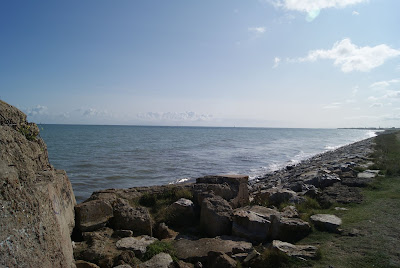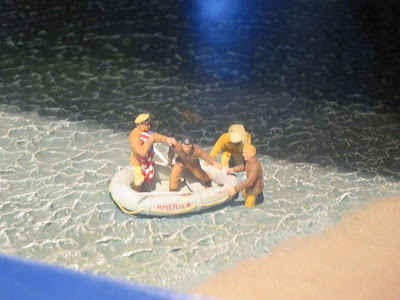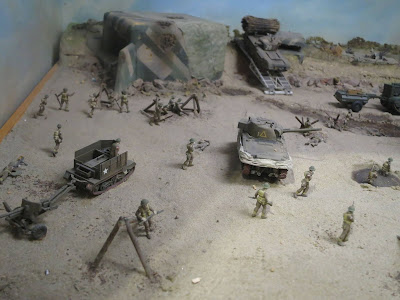Heute jährt sich die Landung in der Normandie zum 74.
Mal. Deshalb möchte ich Ihnen am heutigen Jahrestag ein eher kleines Museum
vorstellen, das ich persönlich aber wirklich liebe.
Es handelt sich um das Musée America Gold Beach (2
Place de l'Amiral Byrd, 14114 Ver-sur-Mer).
Die Bezeichnung verwirrt den Interessenten und Besucher
dann auch anfänglich, denn man fragt sich, warum America?? Wir sind doch hier
am britischen Landungsabschnitt.
Das ist einfach erklärt. Das Museum beschäftigt sich
nämlich mit zwei Ereignissen, die für den Ort Ver-Sur-Mer eine besondere Rolle
gespielt haben.
America bezieht sich nämlich in diesem Fall nicht auf die
USA oder den amerikanischen Kontinent.
Nein.
Es ist der Name eines Flugzeuges, und genaueres werden
Sie gleich erfahren.
Der Begriff Gold Beach erklärt sich wiederum von selbst.
Denn es handelt sich dabei um einen der Landungsabschnitte während der Invasion
in der Normandie im Jahr 1944.
Der Sektor Gold war dabei der westliche der beiden
britischen Landungsabschnitte. Auf der östlichen Seite lag der Abschnitt Sword, zwischen diesen der Abschnitt Juno, an dem die kanadischen Truppen,
unterstützt von britischen Kommandoeinheiten, anlandeten.
Besucht man dieses Museum, dann empfehle ich zunächst
einen Abstecher zum Meer. Hier können Sie sich schon einmal einstimmen; denn
sie fallen förmlich überall über Relikte der ehemaligen Stellungen.
Fahren Sie als erstes Richtung Voie du Débarquement. Von
der Landstraße aus, die die Küstenorte verbindet, kommen sie über die Straße
Herbage de Pres direkt zur Küste.
Diese lang gezogene Zufahrtstraße wird ihnen dann im
Museum auf zahlreichen zeitgenössischen Bildern wieder begegnen.
Erkennungswert garantiert.
Am Strand kommen Sie dann zu dem ehemaligen
Widerstandsnest WN 33. Dort ist heute eine Surfschule und ein
Beobachtungsposten für Rettungsschwimmer etabliert. Beide Bunker sind somit für
Laien nicht unbedingt auf den ersten Blick auszumachen.
Ein erster Überblick zeigt Ihnen hier, dass diese Stelle
durchaus für eine Landung taugte. Ein relativ lang gezogener Sandstrand mit
einem normalen Anstieg. Keine Steilküsten wie am Omaha Beach einige Kilometer
weiter westlich.
Ich selbst habe den Strand im August besucht, und musste
sagen, dass er zu diesem Zeitpunkt ziemlich veralgt war. Badegäste fanden sich
da keine. Vom Look also kein Vergleich zu dem weitgefächerten sauberen Strand
am Omaha Beach.
Zudem müffelte es extrem nach Fisch, Muscheln und Algen,
was mich zu der ironischen Bemerkung veranlasste: Kein Wunder, dass die
Engländer hier so schnell ins Landesinnere vorstießen. Wer will hier schon
verweilen.
Ein paar Kilometer weiter westlich in Richtung Asnelles kommen
sie zu meinem Lieblingsbunker. H677, WN 35. Ich habe ihn liebevoll „Le mouton“
genannt, weil er mich tatsächlich an ein Schaf erinnerte, wie er da so
zusammengefallen am Strand lag.
Wenn ich im Normalfall auch kein Freund von Graffitis
bin, so muss ich dann doch einmal sagen, dass ich diesen Teufelskopf mega treffend
und auch super gelungen fand.
Der zerstörte Bunker hat hier was künstlerisches, neue,
abstraktes bekommen, was sich nach meiner Meinung wirklich sehen lässt. Der
Teufel am Strand. Eine treffende Umschreibung.
Im Abschnitt J und K hier am Gold Beach landete die 50.
(Northumbrian) Infantry Division. Daran erinnern dann auch Wegschilder, die der
Wanderer hier antrifft.
Auch ein weiteres Hinweisschild findet sich hier; und
zwar folgendes.
Betreten Sie dann das Museum verstehen Sie auch, was
dieser Hinweis, den Sie da unten am Strand entdeckt haben, zu bedeuten hat.
Der erste Part des Musée America Gold Beach widmet sich
nämlich den frühen Atlantikflügen.
Wir alle kennen den erfolgreichen Flug von Charles
Lindbergh, der 1927 mit seiner Spirit of St. Louis den Atlantik von New York
nach Paris überquerte. Lindbergh gelang der erste Nonstopflug von New York nach
Paris und die erste Alleinüberquerung des Atlantiks.
Ein ähnlicher Versuch war am 1. Juli des gleichen Jahres
in Ver-sur-mer gescheitert. Der Flugpionier Richard Evelyn Byrd musste hier
notlanden. Seine Geschichte und die seines Flugzeuges, mit dem Namen Fokker
AMERICA NX 206, werden hier umfangreich erläutert.
Auch die Geschichte anderer Flugpioniere wird thematisiert.
Als Modellbauer ist man natürlich immer wieder von
Dioramen begeistert; und das nachfolgende zeigt die Segnung des Flugzeuges,
bevor es sich nach Europa aufmachte.
Auch dieser Überflug über New York hat was.
Ein Diorama mit lebensgroßen Figurinen zeigt wie Byrd bei
einer normannischen Familie unterkommt, nachdem er gerettet wurde.
In einem weiteren Raum wird die Geschichte der Luftfahrt
und vor allem der Luftpost noch weiter thematisiert.
Ich gebe zu, ich war anfänglich verwirrt, weil ich ja mit
einem Kriegsmuseum gerechnet hatte. Na und jetzt ging es erst einmal um zivile
Fliegerei.
Schauen Sie sich aber bitte diesen Teil der Ausstellung
an. Er ist wirklich toll gemacht, ist sehr schön und modern gestaltet. Sogar
ein Film ist per QR Code abrufbar.
Ich poste jetzt mal das Bild. Scannen Sie einfach den QR
Code und Sie sehen den Film.
Wenn Sie diesen ersten Teil der Ausstellung durchquert
haben, gehen Sie eine Treppe herunter und Sie schauen in ein bekanntes Gesicht.
Feldmarschall Montgomery wartet auf Sie.
Der Oberkommandierende der britischen Truppen.
Zunächst werden Sie über die Vorgeschichte der Landung in
der Normandie informiert. Kommandounternehmen, Bombardierungen, aber auch die
Operation Neptune werden Ihnen erläutert.
Einige Highlights der Landung werden Ihnen mit Hilfe von
toll gemachten Dioramen in 1/72 näher gebracht.
Logisch, dass ich hier schwach werde, als alter Fan
dieses Maßstabs.
In diesem Diorama sehen sie die Batterie am Mont Fleury
und das – später so genannte - „Lavatory Pen House“ .
Um was geht es hier?
Im Abschnitt Gold waren die 231. Brigade bei Le Hamel,
und die 69. Brigade der Division bei La Rivière angelandet.
Anfänglicher,
heftiger Widerstand der deutschen Verteidiger hielten die Infanterie nieder,
doch konnten diese sich mit Unterstützung eines Minenräumpanzers und eines
Churchill AVRE Pionierpanzers freikämpfen und ins Landesinnere vorstoßen.
Diese Spezialpanzer werden dann auch in einem anderen
Diorama vorgestellt, das die Situation an WN 33 darstellt.
Die Geschützstellung am Mont Fleury, die das erste
Diorama zeigt, wurde von den 6th Green Howards angegriffen. Als sich eine
Kompanie dieser Einheit verdeckten Bunkern der Deutschen näherte, eröffnete ein
MG das Feuer.
Company Sergeant Major Hollis reagierte sofort. Er griff
die Bunkerbesatzung mit Handgranaten und Maschinenpistolen an.
Zwei Deutsche fielen. Der Rest der Verteidiger war so
verblüfft, dass sich die Bunkerbesatzung widerstandslos gefangen nehmen
ließ.
Im weiteren Verlauf des Tages attackierte die Einheit das
Dorf Crepon.
Hier gerieten sie erneut unter Feuer mehrere MG und eines
Feldgeschütz.
Hollis ging mit einigen seiner Männer in einem Haus in
Deckung, setzte das Geschütz mit einer PIAT außer Gefecht, und zog sich danach
zurück.
Als er merkte, dass zwei seiner Männer aber im Haus
zurückblieben, griff er mit einem leichten MG bewaffnet die deutschen
Stellungen an, zog so das Feuer auf sich, und seine Männer konnten entkommen.
Hollis erhielt für seine Taten das Victoria Cross, die
höchste britische Tapferkeitsmedaille. Übrigens das einzige Victoria Cross, das
am 6. Juni 1944 verliehen wurde.
Im Museum finden sich dann noch weitere Dioramen.
Sehr beeindruckend ist das Diorama, das den Feldfluplatz „Advanced
Landing Ground B 3“ zum Thema hat.
Weitere Szenen sind im nachfolgenden Bild erklärt.
Originale Uniformen mit entsprechenden Kommentaren über
deren Träger (z.B. Major Young, Commander B Company 6th Bat., The Green
Howards), reproduzierte Originalbilder und viele Informationstafeln ergänzen
die Sammlung.
Zum Abschluss gehen Sie noch einem Soldaten des Regiments
East Yorkshire vorbei, der Ihnen das Erscheinungsbild des britischen Soldaten
am D-Day wiedergibt.
Wie Sie sehen können, ist das Museum nicht sehr groß. Sie
werden aber bei einem recht günstigen Eintritt von 4,50 € umfassend zur Landung
am Gold Beach informiert.
Wenn man den Besuch des kleinen, charmanten Museums mit einem
Strandspaziergang verbindet, macht das wirklich richtig Spaß. Kein Informationsoverflow, sondern genau die Portion, die man braucht, um die
Landung an dieser Stelle zu verstehen.
Das Museum bekommt gerade deshalb meine Empfehlung.
Große Waffensammlungen, Fahrzeuge oder gar Panzer finden
Sie hier nicht. Dafür gibt es andere Museen in der Normandie.
Für Besucher der Normandie während der Gedenktage um den
6. Juni herum noch ein kleiner Tipp: In Ver-sur-mer findet sich oftmals auch
das Reenactment Lager der britischen Truppen.
Wenn Sie vom Herbage des Près kommend auf die Avenue
Franklin Roosevelt fahren, kommen sie automatisch hin.
Ich hatte das Glück bereits zweimal hier eine tolle
Reenacter Truppe anzutreffen. Halten
Sie die Augen auf.
Es lohnt
sich.
Today
marks the 74th anniversary of the landing in Normandy
It is
the Musée America Gold
Beach
The name
confuses the visitors initially, because you wonder why America
That's
just explained. The museum deals with two events that played a special role in
Ver-Sur-Mer.
In this
case America does not refer
to the USA
No.
It's the
name of an airplane. I will explain it later.
Again,
the term Gold Beach
is self-explanatory, as it is one of the landing beaches during the invasion of
Normandy
If you
visit this museum, then I recommend a first detour to the sea.
First,
head towards Voie du Débarquement. From the highway that connects the coastal villages,
you come directly to the coast via the road Herbage de Pres.
You will
meet that road again in the museum on numerous contemporary pictures.
Recognition
value guaranteed.
On the
beach you will come to the former resistance nest WN 33. There is now a surf
school and an observation post for lifeguards established. Both bunkers are
thus not necessarily at first sight for laymen.
A first
overview shows you that this place was quite suitable for a landing. A
relatively long sandy beach with a normal ascent. No cliffs like Omaha Beach
I myself
visited the beach in August, and had to say that he was quite stale at the
time. Bathers were not there. No comparison to the wide-spread, clean beach at Omaha Beach
In
addition, it smelled extremely fishy, which led me to the ironic remark: No
wonder that the Englishmen pushed so quickly into the interior. Who wants to
stay here already?
A few
kilometers further west in the direction of Asnelles you will come to my
favorite bunker. H677, WN 35. I lovingly named it "Le mouton" because
he actually reminded me of a sheep lying on the beach.
Under
normal circumstances I am not a friend of graffiti, but that devil’s head is
really impressing.
It’s a
special kind of art,
The devil on the beach.
An apt
description.
Here, at
section J and K of Gold Beach
You see
it clearly near the road.
Another
sign can also be found here.
Then
enter the museum and you will learn waht the signs show you.
The
first part of the Musée
America Gold
Beach
We all
know the successful flight of Charles Lindbergh, who crossed the Atlantic from New York to Paris New York to Paris
and the first solo crossing of the Atlantic .
A
similar attempt had failed on 1 July of the same year in Ver-sur-mer. The
aviation pioneer Richard Evelyn Byrd had to make an emergency landing here. His
story and that of his aircraft, called the Fokker AMERICA NX 206, are
extensively explained in the museum
The
history of other aviation pioneers is also discussed.
Of
course, as a model maker you are always enthusiastic about dioramas; and the
following shows the blessing of the plane before it set out for Europe .
This
overflight over New York
A
diorama full of life-size figurines shows Byrd finding shelter with a Norman
family after being rescued.
In
another room, the history of aviation and airmail in particular will be further
discussed.
I admit
that I was initially confused because I had expected a war museum. Well, and
now it was all about civilian aviation.
But
please take a look at this part of the exhibition. It is really great, very
nice and modern.
Even a
movie is available via QR Code.
I post
the picture now.
Just
scan the QR code and you will see the movie.
When you
have crossed this first part of the exhibition, you go down a staircase and you
look into a familiar face.
Field
Marshal Montgomery is waiting for you.
The
commander-in-chief of the British troops.
First,
you will be informed about the history of the Normandy
Some
highlights of the landing will be brought to you with the help of dioramas in
1/72.
As an
old fan of this scale. I was really impressed.
In this
diorama you will see the battery on Mont Fleury and the - later called -
"Lavatory Pen House".
What is
this all about?
At Gold Beach
These
special tanks will then also be featured in another diorama depicting the
situation at WN 33.
The battery
on Mont Fleury showing the first diorama was attacked by the 6th Green Howards.
When a company of this unit approached, an HMG opened fire, from a hidden germanlmbunker.
Company
Sergeant Major Hollis responded immediately.
He
attacked the bunker crew with hand grenades and a submachine gun.
Two
Germans were killed. The rest of the defenders were so stunned that the bunker crew
could be captured without further resistance.
As the
day progressed, the unit attacked the village of Crepon
Here
they came under fire again from several HMG and a field gun.
Hollis
took cover with some of his men in a house, put the gun out of action with a
PIAT, and then retired.
But when
he realized that two of his men were staying in the house, he attacked the
German positions armed with a light machine gun, and his men escaped.
Hollis
received for his actions the Victoria Cross, the highest British medal for
bravery. By the way, the only Victoria Cross, which was awarded on June 6,
1944.
The
museum also has other dioramas.
Very
impressive is the diorama, which has the landing ground "Advanced Landing
Ground B 3" on the subject. In the diorama you see for example the meeting
of General Eisenhower with Filedmarshall Montgomery on June 15, 1944.
Further
scenes are explained in the following picture.
Original
uniforms with commentary on their wearer (e.g., Major Young, Commander B
Company 6th Bat., The Green Howards), reproduced original images, and many
information boards complete the collection.
Finally,
you will see a soldier from the East Yorkshire Regiment, who gives you the look
of the British soldier on D-Day.
As you
can see, the museum is not very big. But you will be informed about the landing
on Gold Beach
If you
combine this small, charming Museum with a beach walk, it's really great. No
information overflow, but just the portion you need to understand the landing
at this point.
The
museum gets my recommendation for that very reason.
Large arms
collections, vehicles or even tanks can not be found here. There are other
museums in Normandy
For
visitors to Normandy
If you
drive from the Hercage des Près onto the Avenue Franklin Roosevelt, you will
see it automatically.
I've
been lucky enough to find a great british reenacter unit twice here. Keep your
eyes open.
It is worth it.







































































































































































Marvellous post ! The builder of those 1/72 scale dioramas has done some ingeniously clever conversions. Thanks for sharing 👍
AntwortenLöschenYou are welcome John. Yes I was also really impressed.
AntwortenLöschen